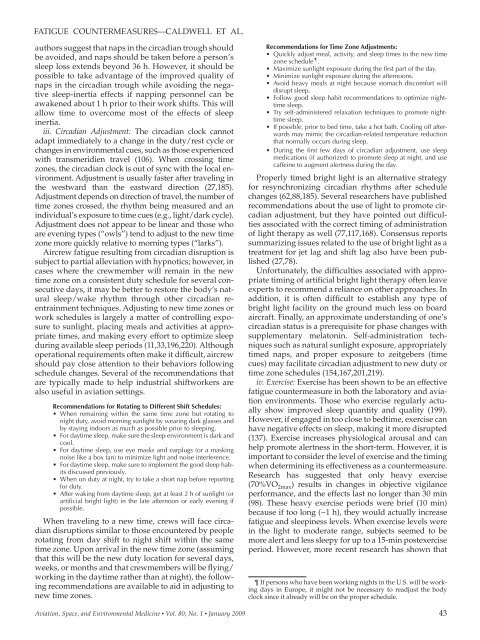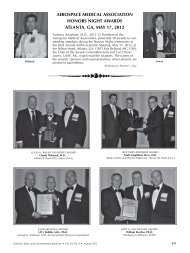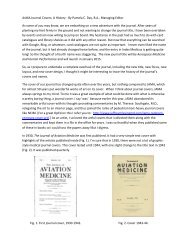Fatigue Countermeasures in Aviation - Aerospace Medical Association
Fatigue Countermeasures in Aviation - Aerospace Medical Association
Fatigue Countermeasures in Aviation - Aerospace Medical Association
Create successful ePaper yourself
Turn your PDF publications into a flip-book with our unique Google optimized e-Paper software.
FATIGUE COUNTERMEASURES — CALDWELL ET AL.<br />
authors suggest that naps <strong>in</strong> the circadian trough should<br />
be avoided, and naps should be taken before a person’s<br />
sleep loss extends beyond 36 h. However, it should be<br />
possible to take advantage of the improved quality of<br />
naps <strong>in</strong> the circadian trough while avoid<strong>in</strong>g the negative<br />
sleep-<strong>in</strong>ertia effects if napp<strong>in</strong>g personnel can be<br />
awakened about 1 h prior to their work shifts. This will<br />
allow time to overcome most of the effects of sleep<br />
<strong>in</strong>ertia.<br />
iii. Circadian Adjustment: The circadian clock cannot<br />
adapt immediately to a change <strong>in</strong> the duty/rest cycle or<br />
changes <strong>in</strong> environmental cues, such as those experienced<br />
with transmeridien travel ( 106 ). When cross<strong>in</strong>g time<br />
zones, the circadian clock is out of sync with the local environment.<br />
Adjustment is usually faster after travel<strong>in</strong>g <strong>in</strong><br />
the westward than the eastward direction ( 27 , 185 ).<br />
Adjustment depends on direction of travel, the number of<br />
time zones crossed, the rhythm be<strong>in</strong>g measured and an<br />
<strong>in</strong>dividual’s exposure to time cues (e.g., light/dark cycle).<br />
Adjustment does not appear to be l<strong>in</strong>ear and those who<br />
are even<strong>in</strong>g types ( “ owls ” ) tend to adjust to the new time<br />
zone more quickly relative to morn<strong>in</strong>g types ( “ larks ” ).<br />
Aircrew fatigue result<strong>in</strong>g from circadian disruption is<br />
subject to partial alleviation with hypnotics; however, <strong>in</strong><br />
cases where the crewmember will rema<strong>in</strong> <strong>in</strong> the new<br />
time zone on a consistent duty schedule for several consecutive<br />
days, it may be better to restore the body’s natural<br />
sleep/wake rhythm through other circadian reentra<strong>in</strong>ment<br />
techniques. Adjust<strong>in</strong>g to new time zones or<br />
work schedules is largely a matter of controll<strong>in</strong>g exposure<br />
to sunlight, plac<strong>in</strong>g meals and activities at appropriate<br />
times, and mak<strong>in</strong>g every effort to optimize sleep<br />
dur<strong>in</strong>g available sleep periods ( 11 , 33 , 196 , 220 ). Although<br />
operational requirements often make it difficult, aircrew<br />
should pay close attention to their behaviors follow<strong>in</strong>g<br />
schedule changes. Several of the recommendations that<br />
are typically made to help <strong>in</strong>dustrial shiftworkers are<br />
also useful <strong>in</strong> aviation sett<strong>in</strong>gs.<br />
Recommendations for Rotat<strong>in</strong>g to Different Shift Schedules:<br />
• When rema<strong>in</strong><strong>in</strong>g with<strong>in</strong> the same time zone but rotat<strong>in</strong>g to<br />
night duty, avoid morn<strong>in</strong>g sunlight by wear<strong>in</strong>g dark glasses and<br />
by stay<strong>in</strong>g <strong>in</strong>doors as much as possible prior to sleep<strong>in</strong>g.<br />
• For daytime sleep, make sure the sleep environment is dark and<br />
cool.<br />
• For daytime sleep, use eye masks and earplugs (or a mask<strong>in</strong>g<br />
noise like a box fan) to m<strong>in</strong>imize light and noise <strong>in</strong>terference.<br />
• For daytime sleep, make sure to implement the good sleep habits<br />
discussed previously.<br />
• When on duty at night, try to take a short nap before report<strong>in</strong>g<br />
for duty.<br />
• After wak<strong>in</strong>g from daytime sleep, get at least 2 h of sunlight (or<br />
artificial bright light) <strong>in</strong> the late afternoon or early even<strong>in</strong>g if<br />
possible.<br />
When travel<strong>in</strong>g to a new time, crews will face circadian<br />
disruptions similar to those encountered by people<br />
rotat<strong>in</strong>g from day shift to night shift with<strong>in</strong> the same<br />
time zone. Upon arrival <strong>in</strong> the new time zone (assum<strong>in</strong>g<br />
that this will be the new duty location for several days,<br />
weeks, or months and that crewmembers will be fly<strong>in</strong>g/<br />
work<strong>in</strong>g <strong>in</strong> the daytime rather than at night), the follow<strong>in</strong>g<br />
recommendations are available to aid <strong>in</strong> adjust<strong>in</strong>g to<br />
new time zones.<br />
Recommendations for Time Zone Adjustments:<br />
• Quickly adjust meal, activity, and sleep times to the new time<br />
zone schedule .<br />
• Maximize sunlight exposure dur<strong>in</strong>g the first part of the day.<br />
• M<strong>in</strong>imize sunlight exposure dur<strong>in</strong>g the afternoons.<br />
• Avoid heavy meals at night because stomach discomfort will<br />
disrupt sleep.<br />
• Follow good sleep habit recommendations to optimize nighttime<br />
sleep.<br />
• Try self-adm<strong>in</strong>istered relaxation techniques to promote nighttime<br />
sleep.<br />
• If possible, prior to bed time, take a hot bath. Cool<strong>in</strong>g off afterwards<br />
may mimic the circadian-related temperature reduction<br />
that normally occurs dur<strong>in</strong>g sleep.<br />
• Dur<strong>in</strong>g the first few days of circadian adjustment, use sleep<br />
medications (if authorized) to promote sleep at night, and use<br />
caffe<strong>in</strong>e to augment alertness dur<strong>in</strong>g the day.<br />
Properly timed bright light is an alternative strategy<br />
for resynchroniz<strong>in</strong>g circadian rhythms after schedule<br />
changes ( 62 , 88 , 185 ). Several researchers have published<br />
recommendations about the use of light to promote circadian<br />
adjustment, but they have po<strong>in</strong>ted out difficulties<br />
associated with the correct tim<strong>in</strong>g of adm<strong>in</strong>istration<br />
of light therapy as well ( 77 , 117 , 168 ). Consensus reports<br />
summariz<strong>in</strong>g issues related to the use of bright light as a<br />
treatment for jet lag and shift lag also have been published<br />
( 27 , 78 ).<br />
Unfortunately, the difficulties associated with appropriate<br />
tim<strong>in</strong>g of artificial bright light therapy often leave<br />
experts to recommend a reliance on other approaches. In<br />
addition, it is often difficult to establish any type of<br />
bright light facility on the ground much less on board<br />
aircraft. F<strong>in</strong>ally, an approximate understand<strong>in</strong>g of one’s<br />
circadian status is a prerequisite for phase changes with<br />
supplementary melaton<strong>in</strong>. Self-adm<strong>in</strong>istration techniques<br />
such as natural sunlight exposure, appropriately<br />
timed naps, and proper exposure to zeitgebers (time<br />
cues) may facilitate circadian adjustment to new duty or<br />
time zone schedules ( 154 , 167 , 201 , 219 ).<br />
iv. Exercise: Exercise has been shown to be an effective<br />
fatigue countermeasure <strong>in</strong> both the laboratory and aviation<br />
environments. Those who exercise regularly actually<br />
show improved sleep quantity and quality ( 199 ).<br />
However, if engaged <strong>in</strong> too close to bedtime, exercise can<br />
have negative effects on sleep, mak<strong>in</strong>g it more disrupted<br />
( 137 ). Exercise <strong>in</strong>creases physiological arousal and can<br />
help promote alertness <strong>in</strong> the short-term. However, it is<br />
important to consider the level of exercise and the tim<strong>in</strong>g<br />
when determ<strong>in</strong><strong>in</strong>g its effectiveness as a countermeasure.<br />
Research has suggested that only heavy exercise<br />
(70%VO 2max ) results <strong>in</strong> changes <strong>in</strong> objective vigilance<br />
performance, and the effects last no longer than 30 m<strong>in</strong><br />
( 98 ). These heavy exercise periods were brief (10 m<strong>in</strong>)<br />
because if too long (~1 h), they would actually <strong>in</strong>crease<br />
fatigue and sleep<strong>in</strong>ess levels. When exercise levels were<br />
<strong>in</strong> the light to moderate range, subjects seemed to be<br />
more alert and less sleepy for up to a 15-m<strong>in</strong> postexercise<br />
period. However, more recent research has shown that<br />
If persons who have been work<strong>in</strong>g nights <strong>in</strong> the U.S. will be work<strong>in</strong>g<br />
days <strong>in</strong> Europe, it might not be necessary to readjust the body<br />
clock s<strong>in</strong>ce it already will be on the proper schedule.<br />
<strong>Aviation</strong>, Space, and Environmental Medic<strong>in</strong>e x Vol. 80, No. 1 x January 2009 43





